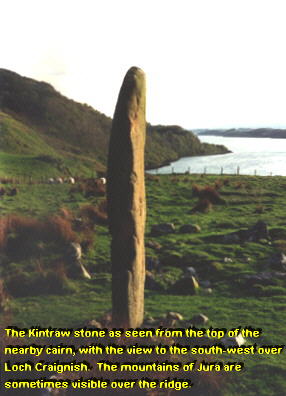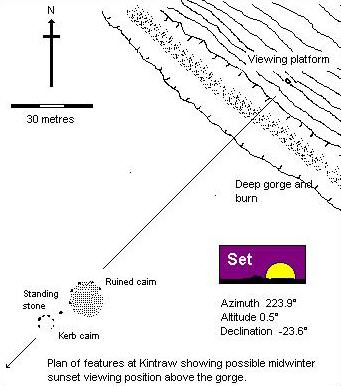
Kintraw, Argyll - standing stone
Stones
of Wonder
QUICK LINKS ...
HOME PAGE
INTRODUCTION
WATCHING
THE SUN, MOON AND STARS
THE
MONUMENTS
THE
PEOPLE AND THE SKY
BACKGROUND
ARCHAEOASTRONOMY
USING
THE SITE DESCRIPTION PAGES
VISITING
THE SITES
THE
LEY LINE MYSTERY
THE
SITES
ARGYLL
AND ARRAN
MID
AND SOUTH SCOTLAND
NORTH
AND NORTH-EAST SCOTLAND
WESTERN
ISLES AND MULL
Data
DATES
OF EQUINOXES AND SOLSTICES, 1997 to 2030 AD
DATES
OF MIDSUMMER AND MIDWINTER FULL MOONS, 1997 to 2030 AD
POSTSCRIPT
Individual
Site References
Bibliography
Links
to other relevant pages
Contact
me at : rpollock456@gmail.com
Standing Stone NM830050*
How to find: The site is in a field beside the Lochgilphead - Oban road (A816), 7km north of Kilmartin, at the head of Loch Craignish.. The stone is visible from the road.
Best time of year to visit:
Winter solstice, 19th -
25th December. It is worth visiting the site on any clear day in winter
when the island of Jura may be visible.

The prehistoric remains
here include a large cairn which has been badly robbed of its stones,
a kerbed cairn which was excavated in 1959-60 and shown to contain a cist1,
and a 4m high standing stone.
This standing stone had been leaning, and finally fell over after a winter of severe rain and frost in March 1979. An excavation2 of the socket which the fall of the stone had exposed was carried out, which showed that only about one metre of the total length of 5.25 metres had been set into the socket. Several packing stones had been jammed in tightly to the socket, but no finds were made during the excavation. After the excavation the stone was re-erected in its original position, then the base was consolidated with concrete. Hopefully it will remain standing for at least another 4,000 years.
The smooth faces of this stone are orienated northeast - southwest. As the ground rises to the northeast, the aspect of the site is in the opposite direction. It was suggested by Alexander Thom3 that the stone marked the backsight position for viewing the setting sun at the winter solstice, the sun going down over mountains on the island of Jura, fully 45km away.
The problem with this idea was that from a position beside the stone, the island of Jura is not actually visible at all because of a ridge just over a kilometre away.
Thom next suggested4 that the site was used because it was the only available level ground on a steep hillside ; original observations of the sun about the winter solstice would have been made from a ledge on the hillside, across the gorge and burn to the north-east. The top of the large cairn would subsequently have been used for yearly observations, with the monolith serving to mark the line.
Because of the distance of the foresight, the right-hand slope of Beinn Shiantaidh on Jura, the site would be a highly accurate solstice line, the sun finally flashing in the col before disappearing. Thom postulated on the basis of this accuracy that the change in the obliquity of the ecliptic since prehistoric times could be used to date the site, and he suggested the stone had been erected about 1800BC.

Euan Mackie, following Thom's hypothesis that observations were made across
the gorge 'from a platform like a short stretch of narrow road cut into
the hillside', excavated on the platform there and found two boulders
with a level rubble pavement, which he suggested was artificial5.
No artefacts were found during the excavation.
The platform can be reached via the bridge at the foot of the hill, and then by following a very indistinct path (likely to be overgrown in summer) along the north side of the gorge. Do not attempt to cross the gorge directly from the standing stone, as it is dangerous.
It has been suggested by other researchers6 that the preliminary observations to establish the solstice line would involve a sideways motion (to the SW) of 30 feet from the day before the solstice to the position for the solstice observation itself. This length of movement is simply not possible from the area available on the ledge while keeping the foresight in view.
So, despite the attentions it has received, the interpretation of the Kintraw site as an accurate astronomical observatory has remained controversial. But a visit to the site is worthwhile before you make a judgement.
The standing stone at Kintraw
The stone at Kintraw, from on top of the nearby cairn